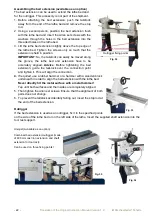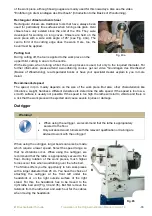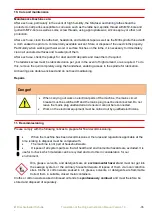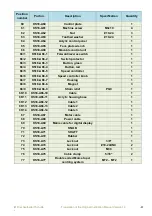
©
Drechselbedarf Schulte
- 32 -
Translation of the Original Instruction Manual Version 1.0
Compare this to working with a plane. If the plane is moved slowly, it is much harder to break the fibres. ´
Fixing end grain on a face plate
End grain blanks must be sawn as round as possible with a band saw before securing them on a lathe.
This makes the start of the
woodturning process easier and
reduces vibrations. A flat surface
is needed to secure the sawn out
blank on a face plate or chuck.
Hollow or arched surfaces may
need to be planed. The face
plate must be screwed to the
blank with at least 6 wood
screws. Using a face plate for
initial positioning is a safe
method, especially for large work
pieces. Modern chucks enable
clamping using chuck inserts or
appropriate bore holes.
When using chucks, read the
operating manual for the relevant
chuck.
Fig. 39 Face plate
Positioning of the tool rest
Fig. 40 Tool position
When roughing, set the tool rest slightly below
the spindle centre line so the blade can
engage slightly above the middle. The
roughing gouge is used until the imbalance is
removed (see Fig 40).
To process the shape, a spindle gouge is
used. It engages noticeably above the work
piece centre.
Cylindrical shapes can be smoothed with a
chisel. Here, too, the chisel engages
noticeably above the centre of the work piece
(see Fig. 40a).
So-called "fillets" are cut with the beading tool
or cut-off tool. The tool engages above the
centre.
Roughing gouge
A spindle-roughing gouge is used for
between-centre work to remove the corners from square stock, turn cylinders, tapers, and long shallow
curves. A distinction is made between the English "deep-fluted" and the German "shallow-fluted"
roughing gouge. Do not try using the deep-fluted English style spindle-roughing gouge for bowls. The
shallow-fluted German or Continental gouge can also be used for end grain wood.
Spindle gouge
The spindle gouge is used for between-centre work to create large and small shapes such as coves,
beads, ogees etc. and for the last smoothing cut.
Changes in work piece diameter are partly compensated for by adjusting the forearm. Spindle gouges
always shape the side grain slightly above the work piece centre. Spindle gouges are nearly always held
with the cutting edge almost vertically and they
ONLY
ever cut with in the bevel-rubbing mode, close to
the front curve, the cutting edge. Furthermore, when cutting with the spindle gouge, the bevel is always
applied. When working with end grain, the shallow-fluted roughing gouge can be used on the underneath
Содержание FU-230
Страница 1: ...FU 230 WOOD TURNING LATHE...





























